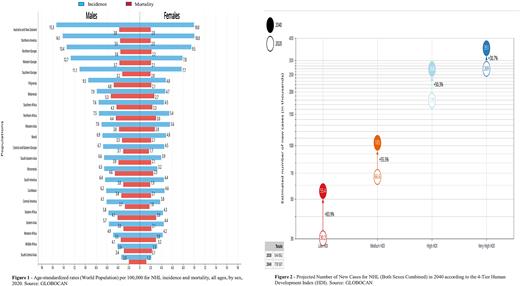Abstract
INTRODUCTION The burden of cancer incidence and mortality including non-Hodgkin lymphoma (NHL) is expected to grow worldwide as populations grow, age, and adopt lifestyle behaviors that increase cancer risk, many of which are associated with socioeconomic development. Describing the current and future epidemiologic impact of NHL is crucial to evaluate the therapeutic demand and to inform adequate healthcare resource allocation. However, very few recent studies have described global estimates of non-Hodgkin lymphoma diagnoses, cancer burden, and future projection. In this study, we summarize the current burden, trends, risk factors, prevention, early detection, and survivorship of non-Hodgkin lymphoma that account for approximately 2.9% of the cancer burden among both men and women worldwide.
METHODS Estimates of new cancer cases (incidence data) and cancer deaths (mortality data) in the year 2020 were extracted from Global Cancer Observatory (GLOBOCAN) database. GLOBOCAN provides country-specific estimates of cancer incidence, mortality, and prevalence for 185 countries or territories and 36 cancer types by age group and sex. Global geographic variability was assessed using 20 predefined world regions. For US rates, data from National Cancer Institute's (NCI's) Surveillance, Epidemiology, and End Results (SEER) 22 were assessed. All mortality data in the GLOBOCAN database was extracted from the World Health Organization (WHO) mortality database available through 2019. Rates are age-standardized (ASRs) (per 100,000 person-years) using the world Standard Population. We characterize the burden according to the 4-tier Human Development Index (HDI) by the United Nations Development Program. Finally, we provide a prediction of the future burden of NHL in 2040 based on demographic projections, assuming that national rates estimated in 2020 remain constant.
RESULTS NHL ranked as the 5th to 9th most common cancer in most countries globally, with an estimated 544,000 new cancer cases and 260,000 cancer deaths in 2020. NHL incidence rates varied by approximately 5-fold in both men and women across WHO areas. The highest age-standardized incidence rates for both sexes (per 100,000) were observed in Australia and New Zealand (12.5) and North America (12), while the lowest rates were in South-Central Asia (2.7), a 4.6-fold difference. Regions with very high HDI had higher rates of NHL (9.3) than regions with medium HDI (3.1) and lower HDI (4.5). However, international variability in NHL mortality rates is smaller: 2.5-fold for both sexes. The lowest mortality rates were in South-Central Asia (1.6) and the highest rates were in Melanesia (4). In the United States, the age-standardized NHL incidence rate (per 100,000) doubled from 1975 (11) to 2007 (21.3) and then stabilized, while the 5-year relative survival rates improved from 47% in 1975 to 73.8% in 2018. These changes have significantly impacted age-adjusted NHL mortality rates (per 100,000), which were 5.6 in 1975, peaked at 8.9 in 1997, and have been decreasing since that time, most recently at 5 in 2019. Similar broad temporal trend patterns were observed in other western countries. In Asia, NHL incidence rates have not plateaued, and have shown rises in Japan during 1993-2010 and in Republic of Korea during 1999-2012. Worldwide, an estimated 779,000 new NHL cases are projected to occur in 2040, a 43% increase from the corresponding 544,000 cases in 2020, assuming national rates remain constant.
CONCLUSION There is marked variation in NHL incidence rates among different populations of the world. NHL incidence and mortality rates have steadily increased in the United States and other populations over the past few decades, making NHL an increasingly important contributor to the global cancer burden. This epidemiologic assessment also reveals substantial growth in new NHL diagnoses over the next two decades. Keeping track of new cases, deaths, trends, and survival over time helps us understand where progress is made and where additional research is needed to address challenges.
Disclosures
No relevant conflicts of interest to declare.
Author notes
Asterisk with author names denotes non-ASH members.


